Ever wondered how to steer your software tester resume into the spotlight? Our ultimate guide is packed with practical tips, effective examples, and step-by-step instructions for turning your resume from a rough draft to refined content — a 'good-to-go-live' product if you will.
And so, without further ado, let's delve into the fine details of:
- Formatting your software tester resume
- Appropriately including your personal information in your resume
- Crafting a compelling resume summary or objective
- Selecting key software testing skills
- Detailing relevant work experience and key projects
- Including extra sections into your tester resume
- Avoiding common resume mistakes
- Understanding the key difference between a resume and a cover letter
- Unveiling the average salary and job outlook for software testers
- Exploring top resources for job-seeking testers
1. How to properly format your software tester resume
What's on your page is crucial, but how it's laid out can make all the difference. There are three main types of resume formats favored by job seekers: Chronological, Functional, and Hybrid. Let's lift the lid on all three:
1. Chronological format: This is the most common and straightforward resume format. It projects your work experience in a 'timeline' manner, with your most recent experience at the top moving backward. For a software tester, this format can highlight your career progression and mastery level in different testing tools and methodologies.
Listing your work experience reverse-chronologically
Work Experience
Senior Software Tester, XYZ Corp. (2020 - Present)
- Project lead on automated testing using Selenium for Banking software.
Software Tester, ABC Tech. (2018 - 2020)
- Spearheaded functional testing for healthcare software.
2. Functional format: This format is less common but can be valuable when you're switching careers or have gaps in your career history. It emphasizes specific skills over chronological work history. For software testers transitioning from another IT role or fresh graduates, this can spotlight your testing knowledge, even without a wealth of work experience.
Emphasizing your skills in a functional resume
Skills
- Automated testing: Proficient with Selenium WebDriver, TestComplete and LoadRunner.
- Data analysis: Experience with Apache Hadoop, Tableau and Excel.
3. Hybrid format: The hybrid format is, as you might have guessed, a combination of the chronological and functional formats. It highlights your skills at the top before delving into your work history.
This can be beneficial for seasoned software testers who want to show off their impressive range of competencies alongside their work achievements.
Hybrid resume format listing
Skills
- Manual Testing: Exceptional debugging skills with various manual testing tools.
- Automated Testing*: Proficient in scripting automated tests using QTP, Selenium.
Work Experience
Lead Software Tester, DEF Inc. (2017- Present)*
- Managed the transition from manual to automated testing process, increasing efficiency by 50%.
Remember, each format has its perks and perils. And its choice depends really on your work history, skills, and career objectives.
2. How to include your personal information in a resume
The personal information section, also known as a resume header, is your virtual handshake with the recruiter. It should contain your full name, contact details like phone number and email, and your location. It's a simple section but essential to get right:
- The email address should be professional and straightforward, ideally a combination of your first and last name.
- Your location should detail your city and state, but avoid including full address details for privacy reasons.
- In the digital age, including your LinkedIn profile and portfolio link is a cutting-edge move. It gives your potential employer a deeper, wider window into your professional persona. Here’s how to do it:
Here's a header example for your software tester resume
John Doe
Los Angeles, CA
123.456.7890
john.doe@email.com
LinkedIn: linkedin.com/in/johndoe
Portfolio: johndoeportfolio.com
Notice how clean and uncluttered that looks? There's no overload of information, yet a recruiter has multiple avenues of learning more about you.
Remember, though, if you're going to include a LinkedIn or portfolio link, make sure those resources are up-to-date and resonate with your resume. The last thing you want is for your LinkedIn to tell a different story than your CV.
3. How to craft a compelling resume summary or objective
The section that takes the stage after your header, often in the limelight, is the resume summary or objective, serving as your elevator pitch.
This is where you present who you are professionally, what you can bring to the table, and what you aim to achieve in your next role.
- A resume objective is essentially your professional goal — this is often used by fresh graduates or career changers, as they may lack direct job experience to summarize. It serves to illustrate your career direction and how the role fits into your plan.
Incorrect resume objective example
Looking for a Software Tester position.
Why is it weak? This example is too generic, lacks personalization and doesn't mention how the company would benefit from hiring you.
Correct resume objective example
Recent Computer Science graduate with an honors project in automated testing seeks Software Tester role at ABC Corp to utilize knowledge of Selenium WebDriver and Agile methodologies.
Why does it work? This objective is specific, ties the candidate's education to the job and makes a mention of how the candidate can contribute.
- A resume summary, on the other hand, is a condensed version of your career highlights and skills. Professionals with some years of experience under their belt should ideally use this. It's a snapshot of your capabilities and achievements.
Incorrect resume summary example
Experienced Software Tester seeking a challenging role.
Why doesn’t it work? This is too generic, it could apply to any software tester and it misses out on an opportunity to highlight particular skills or achievements.
Correct resume summary example
Detail-oriented Software Tester with over 5 years of experience in manual and automated testing. Developed comprehensive test cases that improved bug detection by 30% at XYZ Inc. Skilled in Selenium, JIRA and Agile methodologies, I seek to leverage my proven track record at ABC Corp.
Why is it strong? The latter summary gives a clear picture of the candidate’s skills, experience, and accomplishments, making it easier to visualize their potential contributions to the company.
When crafting your summary or objective, think about what you can offer the employer, not just what you want from the job. Tailor it to the specifics of the software tester job ad, and you'll be heading in the right direction.
4. How to choose the top skills for your software tester resume
The skills section is the best avenue to convey your practical abilities to your potential employer. And it's crucial to differentiate between hard and soft skills, both of which are important for a software tester.
- Hard skills are technical or specific abilities that can be taught and measured. For a software tester, these revolve around using specific testing tools, coding languages, and key methodologies.
- Soft skills, on the other hand, are related to how you work. They're often personality traits or habits that shape how you handle work and interact with others.
When picking your skills, the key is relevance. Cherry-pick those skills that resonate with the job description. This will show the employer that you're not just capable, but you're what they're looking for.
Here's a roundup of some skills to consider:
Hard skills for your software tester resume
- Automated testing tools (like Selenium, JMeter)
- Manual testing
- Test case creation
- Knowledge of Agile/Scrum
- Performance testing
- Debugging
- Knowledge of SQL databases
Soft skills to include in your software tester resume
- Analytical thinking
- Attention to detail
- Problem-solving
- Effective communication
- Time management
- Team collaboration
- Adaptability
To sum it up, treat your skills section like a successful software testing session — precise, on-point, and thoroughly immersing the user (or in this case, the recruiter).
Employ this combination of hard and soft skills that are custom-fit to the job description, and you'll be without a "bug" in your employability armor.
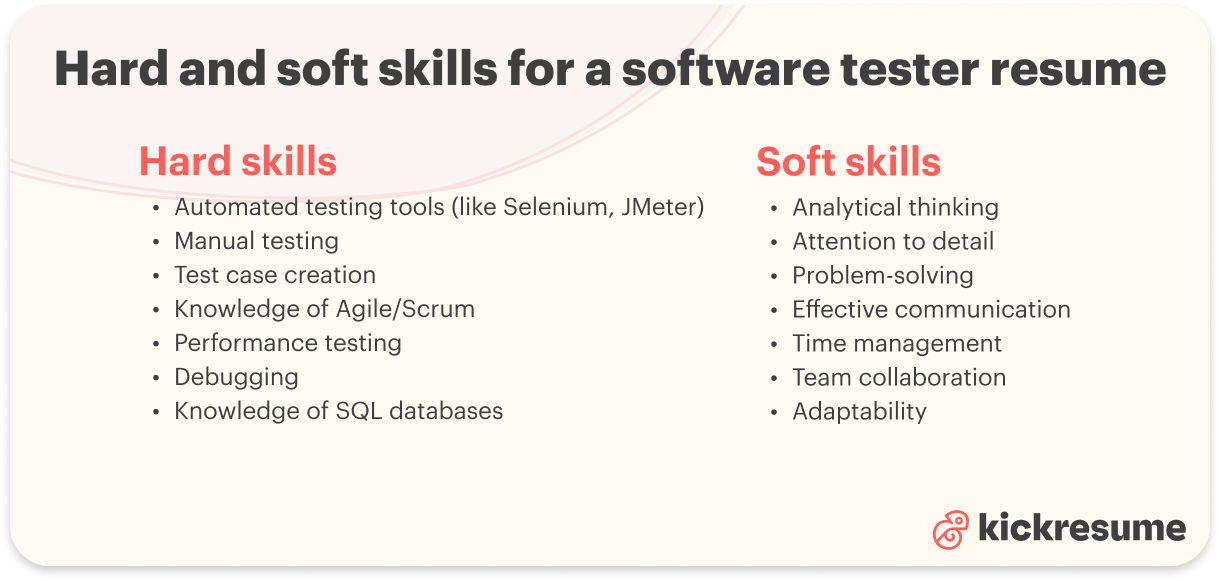
5. How to craft your work experience and key projects section
The work experience and key projects section is the beating heart of your software tester resume. Here, you're demonstrating proven experience and achieved milestones that align with the potential role you're aiming to land.
This section should be consistently formatted — characterized by a string of bullet points prefaced by your role, the company, and your tenure in that position.
The bullets must begin with an action verb and follow through with your specific responsibility or achievement, ideally ending with a quantifiable result.
Here's your vocabulary starting kit
- Implemented
- Coordinated
- Streamlined
- Efficient
- Creative
- Analytical
Now, let’s take a look at two contrasting examples of listing work experience in a software tester resume:
Weak work experience and key projects section example
Software Tester
XYZ Tech
2016-2018
- Worked on testing
- Contributed to team projects
- Used Selenium
Why is it weak? In this example, the bullet points are vague and don't tell a compelling story about your abilities or contributions. They lack detail and aren’t quantified.
Strong work experience and key projects section example
Senior Software Tester
XYZ Tech
2018 - Present
- Developed and executed comprehensive test cases that increased defect detection by 30%.
- Spearheaded a cross-functional team in the integration of automated testing processes for Project Phoenix, reducing manual testing hours by 45%.
- Championed the use of Selenium for automated testing, improving test efficiency by 40%.
Key Projects
- Project Phoenix: Led the implementation of automated tests, reducing manual testing effort by 45%.
- Project Delta: Coordinated a team of 5 testers for end-to-end testing of the new billing module, ensuring 99% accuracy before go-live.
Why is it strong? This version is packed with action verbs, specific tasks, and quantifiable achievements. It demonstrates your value and gives a precise idea of what the recruiter can expect from you.
Additionally, key projects are clearly indicated with an explanation of your role and the outcome. This section of your resume is your proven compatibility with the job at hand. Make sure it's a match!
In a nutshell, your work experience and key projects section should be a strategically curated showcase of your career hi-lites reel. Take it as an opportunity to demonstrate how your past performances have rehearsed for the role you're applying for. You're not just a software tester — you are an asset.
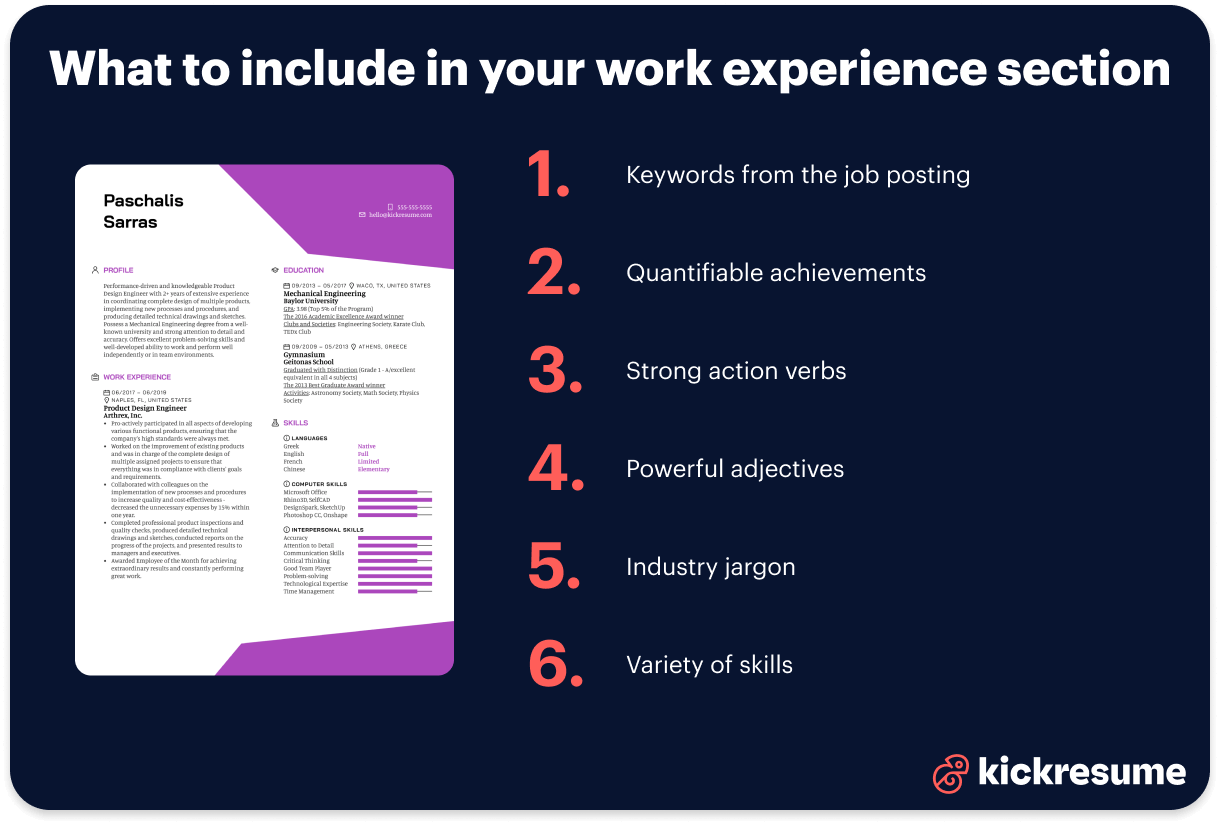
6. How to list your education on a software tester resume
When it comes to resumes, education matters. Not just as a basic requirement, but as an insight into your background and learning journey.
For software testers, listing your education can showcase your academic repertoire, technical foundation, and continued learning eagerness.
If your degree is in a related field (e.g., Computer Science), highlight it:
Directly relevant education section example
Bachelor's in Computer Science
XYZ University, Somewhere, USA (2015-2019)
- Graduated cum laude, with an honors project on software testing automation
- Relevant coursework: Software Quality Assurance, Systems Analysis, and Design
Here, the degree, university, and years attended are conspicuously displayed. Academic accomplishments and relevant coursework also spotlight thematic consistency with the software tester role.
If your degree is not directly related (let's say, a degree in Biology), showing applicability or growth towards the field is handy:
Non-directly relevant education section example
Bachelor's in Biology
XYZ University, Somewhere, USA (2015-2019)*
- Led a data analysis project using Python scripting
Certifications
- Certified Software Tester (CSTE) — Software Certifications
- Python for Data Science — Coursera
In this case, an additional certifications section showcases a dedicated effort to develop relevant skills outside the sphere of formal education.
All in all, whether your degree is in a related field or not, your education section has a key role to play. It paints a picture of your academic foundation, your journey of growth, and your commitment to the field. It's not just about where you started, but how far you've been willing to go.
7. How to select relevant extra sections for your resume
When fashioning your software tester resume, you might very well have a trove of experiences and skills that don't neatly fit into the standard education or work experience sections.
Here's where relevant extra sections come into play. They help provide a fuller image of you as a candidate.
Select additional sections that further strengthen your application and resonate with the job description. Remember, the goal is to provide valuable information without swelling your resume unnecessarily.
Let's run through a few examples:
- Volunteering: Voluntarily providing your skills not only showcases your charitable side but also indicates real-world experience. For instance, tutoring experience indicates a solid understanding of software testing principles and an ability to explain complex ideas clearly — highly beneficial to roles involving teamwork or mentorship.
- Certifications: In a field as dynamic as software testing, keeping up to date with trends and tools often involves completing various certifications. And they certainly show your continued educational efforts, expertise, and dedication to the field.
- Professional associations: Membership in recognized industry groups shows your proactive engagement with the field
Here’s how to list extra sections on your resume
Volunteer Experience
- Computer Science Tutor, Local High School, (2017-2018)
- Guided students in understanding coding basics and software testing principles.
Certifications
- ISTQB Certified Tester
- Certified Agile Tester, Scrum Alliance
Professional Associations
- American Software Testing Qualifications Board (ASTQB)
- Association for Software Testing (AST)
Extra sections can simply give recruiters a more rounded view of who you are and what you bring to the table. Make sure they enhance your story and aren't just filler. Remember, quality over quantity is key.
8. How to avoid common mistakes in a software tester resume
Even with all the required skills and experience, a few slip-ups on your resume can send it straight to the 'no' pile. Let's take a look at three common mistakes and how to avoid them:
- Grammar and spelling errors: These reflect poorly on your attention to detail. Remember, as a software tester, meticulousness is key. Use grammar-checking tools, but also proofread manually. A fresh pair of eyes can often spot errors software might overlook.
- Being too generic: Customizing your resume for each job application takes time, but recruiters can sniff out a generic resume from miles away. To make an impact, tailor your resume to align with the job description, emphasizing relevant skills, and experiences.
- Focusing on responsibilities over achievements: Instead of drily listing your duties, highlight the results or impacts of your work. Did your testing improve software stability? How much? Did you lead a team to meet a challenging deadline? Show it.
- Overloading with irrelevant information: Be picky about what you include. If it doesn't help sell you for the specific role you're applying to, consider leaving it out. Maintaining focus on relevant information will make your resume more compelling and easier to digest.
Avoiding these common pitfalls will ensure your software tester resume keeps its audience engaged, maximizes impact, and escalates you from the application pool to the interview list.
9. When to include a software tester cover letter
Let's shed light on a common quandary: The relevance of a cover letter and when to pair it with your software tester resume.
While your resume presents a broad overview of your career history, skills, and achievements, a cover letter tells a story, illuminating why you're the perfect fit for a specific role.
It's a common misconception that cover letters are passé. In fact, many hiring managers still read them and appreciate the personal touch they convey.
So, when should you include one? As a rule of thumb, if the job application asks for it, provide it. Even if not explicitly stated, it’s usually beneficial to include a well-written cover letter, as it gives you an additional platform to showcase your motivation and fit for the role.
Remember, a resume is about you as a professional, while a cover letter is about the employer — why you are drawn toward their mission, why you want to work for them, and why you fit the specific role.
Pro tip: Tailor each cover letter to the job you're applying for. A generic template won't cut it. Specificity shows your genuine interest in the job and the effort you've made in applying.
Ultimately, a cover letter and a resume are like a two-course meal to satisfy recruiters' appetite. They complement each other and, together, offer a comprehensive understanding of your career story.
10. Average salary and outlook for software testers
The dynamic, evolving world of software testing offers not only a stimulating career path but also an impressive earning potential. As of May 2022, the average annual salary for a software tester was a striking $124,200 as reported by the Bureau of Labor Statistics (BLS).
But the laurels of this profession don't stop at lucrative remuneration. The job outlook for software developers, quality assurance analysts, and testers is especially promising and set for steady growth.
Specific projections suggest a 25 percent employment growth from 2022 to 2032, a rate that notably outpaces the average for all occupations.
This surge in employment means that there will likely be about 153,900 new job openings for software developers, quality assurance analysts, and testers each year for the next ten years.
A career in software testing not only offers a competitive salary but also an optimistic employment outlook, making it a compelling choice in the realm of IT careers.
11. Top resources for job-seeking software testers
Arming yourself with the right resources can nudge you closer to your dream job as a software tester. Here are some must-have tools in your job-seeking arsenal:
- Job search websites: Platforms like LinkedIn, Indeed, Glassdoor, and many more are your starting place. They offer extensive job listings, company reviews, and even salary estimates.
- Recruiting agencies: Specialized agencies like Robert Half Technology or CyberCoders often have listings for software testing roles. These can be particularly useful for finding opportunities that aren't advertised on major job boards.
- Professional networking: Build your professional network both online and offline. Join LinkedIn groups, engage with industry leaders on Twitter, and attend tech meetups in your area.
- Software testing blogs and forums: Stay updated with the latest in your field. Sites like Ministry of Testing, QAInsights, and SQAForums can provide valuable insights and knowledge.
- Improve your skills: Leverage online learning platforms like Coursera, Udemy, or freeCodeCamp to hone your existing skills or pick up new ones.
- Certification courses: Get certified from recognized institutions like ISTQB to give your resume that competitive edge.
- Job interview prep sites: Use platforms like LeetCode, HackerRank, or Pramp to practice coding interviews. Not only for developers, but they also feature systems design and QA problems.
Remember, the job market is dynamic. Keep learning, keep networking, and keep up-to-date with industry trends. Your perfect software testing job might be just around the corner!
Oh, and if you want to turn your LinkedIn profile into a polished resume with just one click, we've got you covered.
Software Tester Resume FAQ
How long should my software tester resume be?
Ideally, aim for a one-page resume if you have less than 10 years of experience. If you have more extensive experience, a second page could be necessary. Still, always aim for brevity and relevance.
Should I include references on my software tester resume?
Including references on your resume is no longer a common practice. Instead, have a separate list of references ready to provide upon request.
How can I make my software tester resume stand out if I am a recent graduate or changing careers?
Highlight relevant coursework, independent projects, certifications, or transferable skills in your resume. Even without direct work experience, showing your knowledge, initiative, and enthusiasm for the field can make a positive impression.
Do I need to include a photo on my software tester resume?
In general, it's best to avoid including a photo on your resume unless the job ad specifically asks for one. Focus instead on your skills, experience, and qualifications.
How often should I update my software tester resume?
It's advisable to keep your resume up-to-date, even if you're not actively job seeking. Aim to review and update your resume at least every six months or any time you learn a new skill, achieve a significant result, or complete a noteworthy project. This way, you're always ready for any opportunity that comes your way.

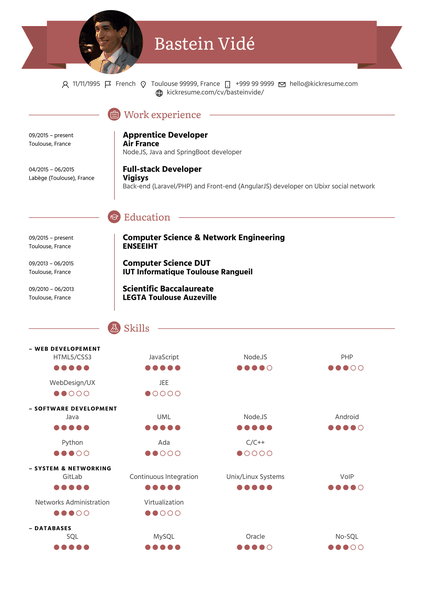

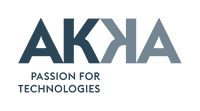


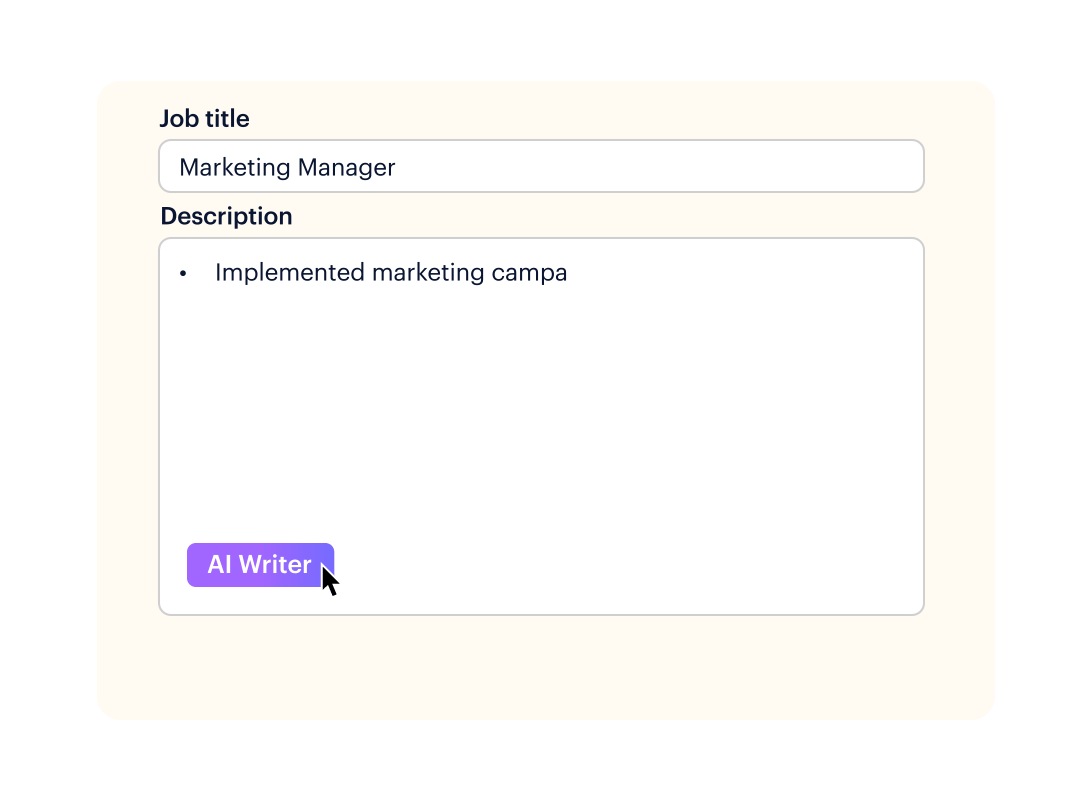

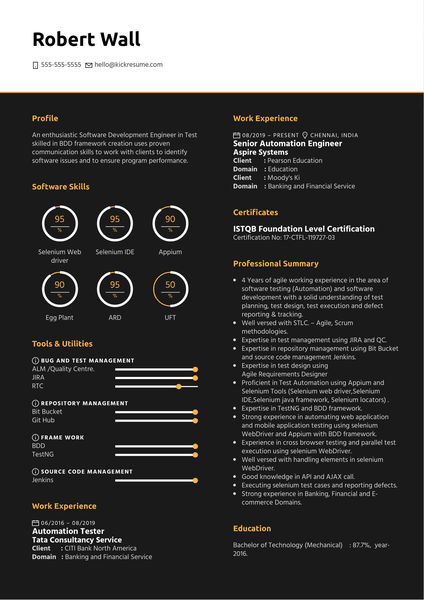
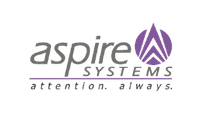


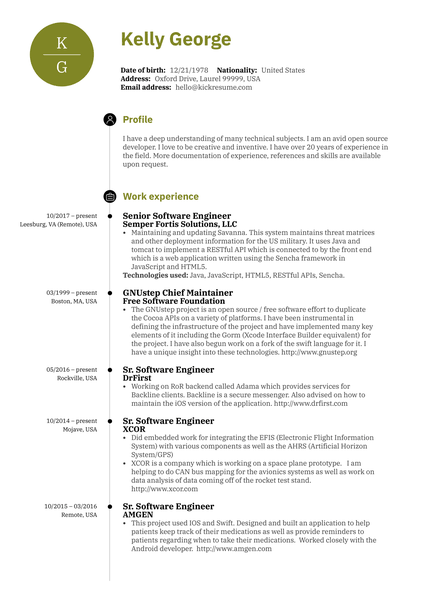

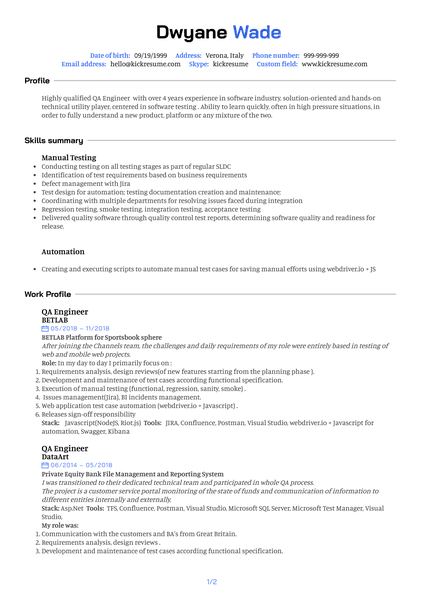

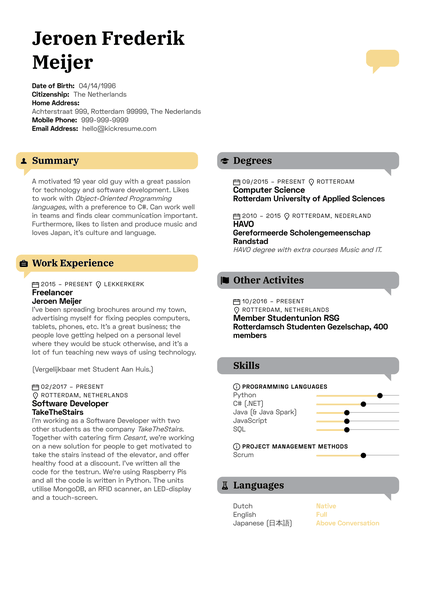

![Software Developer [swedish] Systemutvecklare](png/thumbnail-58.png)
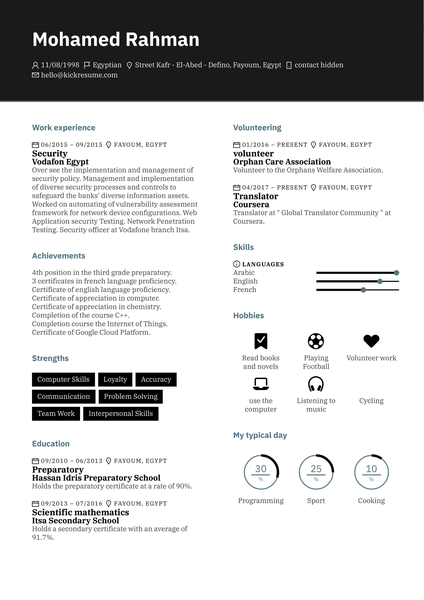

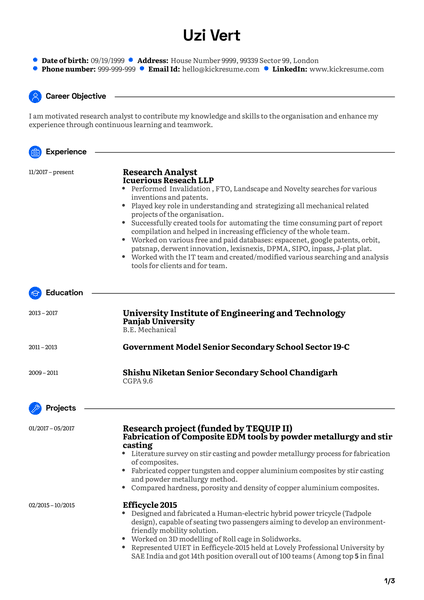
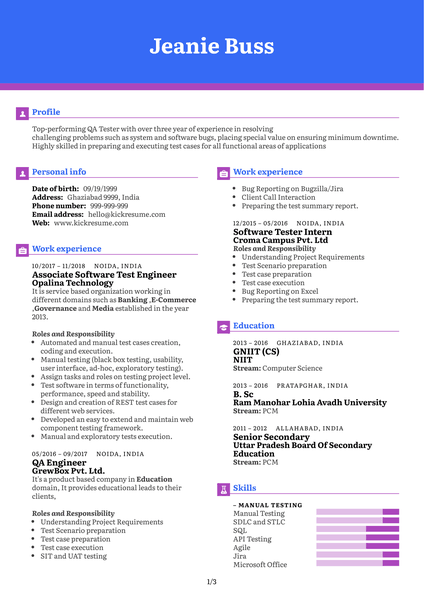

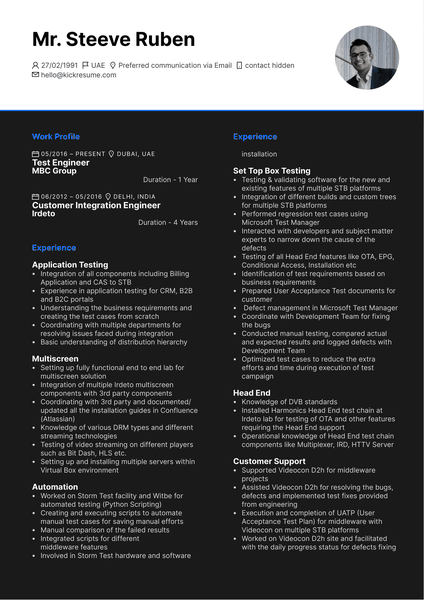

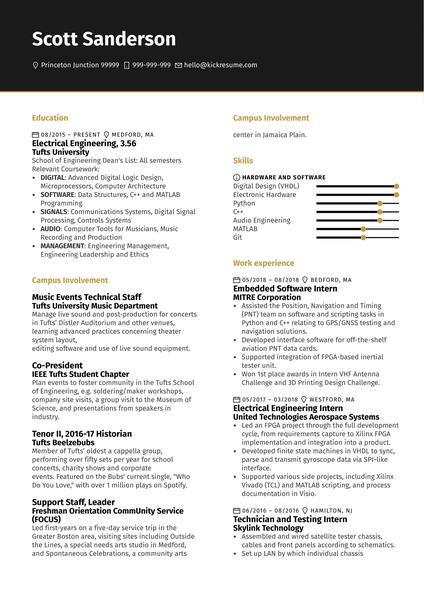

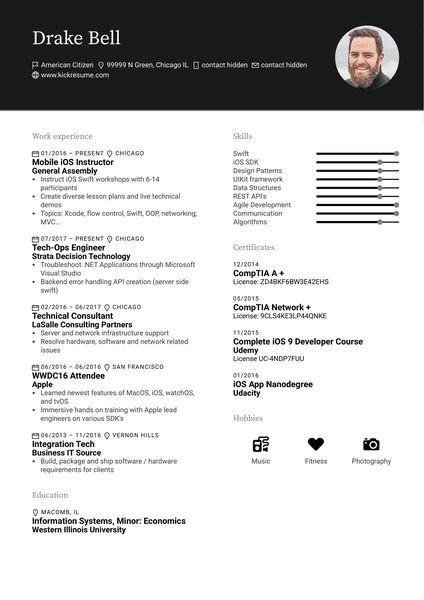

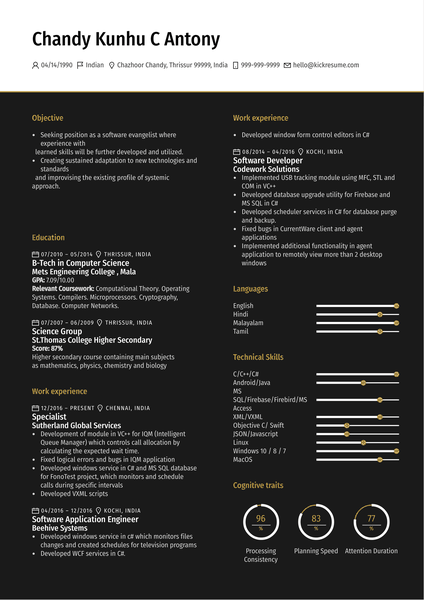

![Webmaster/webmestre Resume Example [FR]](png/thumbnail-78.png)
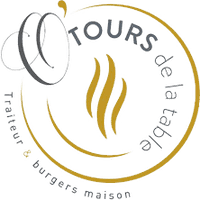
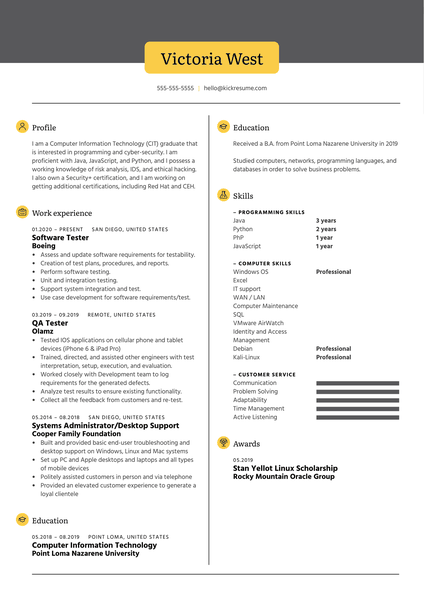
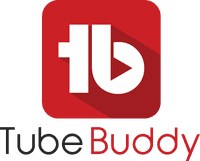
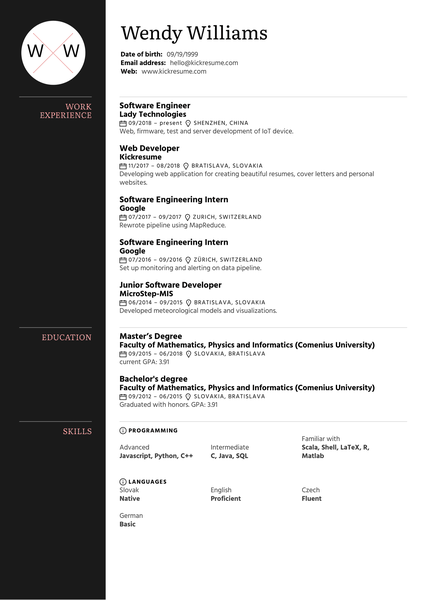

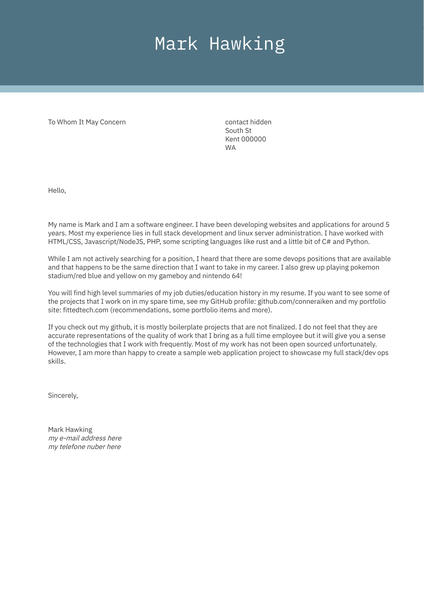
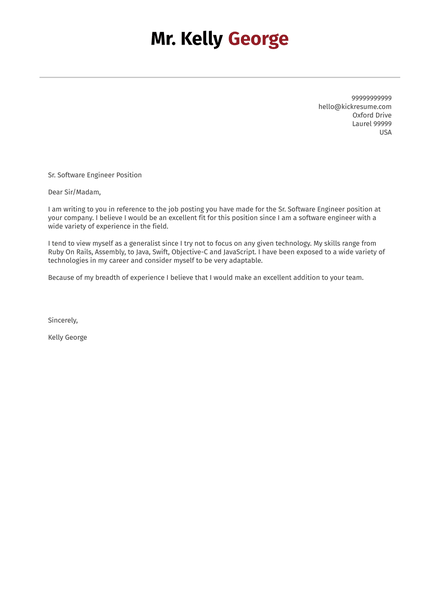
![Webmaster/webmestre Cover Letter Example [FR]](png/thumbnail-82.png)


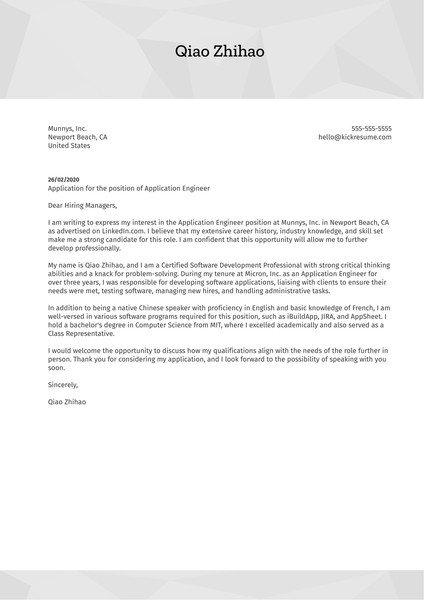
![How to Write a Professional Resume Summary? [+Examples]](https://d2xe0iugdha6pz.cloudfront.net/article-small-images/i-Profile.svg)
![How to Put Your Education on a Resume? [+Examples]](https://d2xe0iugdha6pz.cloudfront.net/article-small-images/i-Collage-Universities.svg)
![How to Describe Your Work Experience on a Resume? [+Examples]](https://d2xe0iugdha6pz.cloudfront.net/article-small-images/Experience.svg)


